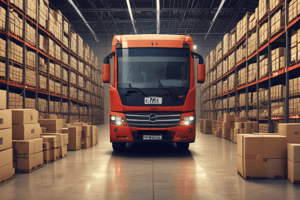Podcast
Questions and Answers
What is the primary goal of Supply Chain Management?
What is the primary goal of Supply Chain Management?
- To reduce transportation costs
- To minimize inventory costs
- To optimize the flow of materials, information, and finances (correct)
- To maximize profit margins
What is the main function of Transportation Management Systems (TMS)?
What is the main function of Transportation Management Systems (TMS)?
- To manage warehouse storage
- To optimize routes and reduce costs (correct)
- To track inventory levels
- To forecast demand
What is the primary role of a Freight Forwarder?
What is the primary role of a Freight Forwarder?
- To coordinate shipments and arrange transportation (correct)
- To manage warehouse inventory
- To provide insurance services only
- To handle customs clearance only
What type of warehousing is owned by a single company?
What type of warehousing is owned by a single company?
What is the primary goal of Inventory Management?
What is the primary goal of Inventory Management?
What is the primary benefit of using a Warehouse Management System (WMS)?
What is the primary benefit of using a Warehouse Management System (WMS)?
What is the primary role of Supply Chain Management in logistics?
What is the primary role of Supply Chain Management in logistics?
What is the primary benefit of using a Transportation Management System (TMS)?
What is the primary benefit of using a Transportation Management System (TMS)?
What type of transportation combines multiple modes of transportation?
What type of transportation combines multiple modes of transportation?
What is the primary goal of Freight Forwarding?
What is the primary goal of Freight Forwarding?
Flashcards
Logistics
Logistics
Planning, coordinating, and executing the movement and storage of goods, products, and resources.
Supply Chain Management (SCM)
Supply Chain Management (SCM)
Managing materials, information, and finances from supplier to customer.
Transportation Management
Transportation Management
Planning and carrying out the movement of goods.
Freight Forwarding
Freight Forwarding
Signup and view all the flashcards
Warehousing
Warehousing
Signup and view all the flashcards
Inventory Control
Inventory Control
Signup and view all the flashcards
Modes of Transportation
Modes of Transportation
Signup and view all the flashcards
TMS (Transportation Management System)
TMS (Transportation Management System)
Signup and view all the flashcards
WMS (Warehouse Management System)
WMS (Warehouse Management System)
Signup and view all the flashcards
Inventory Levels
Inventory Levels
Signup and view all the flashcards
Study Notes
Logistic Overview
- Logistic refers to the planning, coordination, and execution of the movement and storage of goods, products, and resources from one place to another.
- It involves the integration of information, transportation, inventory, warehousing, material handling, and packaging.
Supply Chain Management
- Supply Chain Management (SCM) is the oversight of materials, information, and finances as they move in a process from supplier to manufacturer to wholesaler to retailer to consumer.
- SCM involves:
- Sourcing and procurement
- Production planning and scheduling
- Inventory management
- Transportation and logistics
- Demand forecasting and management
Transportation Management
- Transportation Management involves the planning, coordination, and execution of the movement of goods and products from one place to another.
- Modes of transportation:
- Land transportation (trucks, trains, buses)
- Air transportation (airplanes, helicopters)
- Water transportation (ships, boats)
- Intermodal transportation (combines multiple modes)
- Transportation management systems (TMS) help optimize routes, reduce costs, and improve delivery times.
Freight Forwarding
- Freight Forwarding is the coordination and shipment of goods from one place to another via a third-party logistics provider.
- Freight forwarders:
- Arrange for transportation
- Handle customs clearance and documentation
- Provide insurance and tracking services
- Consolidate and de-consolidate shipments
Warehousing
- Warehousing involves the storage of goods and products in a facility until they are needed.
- Types of warehousing:
- Private warehousing (owned by a company)
- Public warehousing (shared by multiple companies)
- Bonded warehousing (for goods subject to customs duties)
- Automated warehousing (uses technology and robotics)
- Warehouse management systems (WMS) help optimize storage, inventory, and order fulfillment.
Inventory Control
- Inventory Control involves the management of inventory levels, including tracking, ordering, and storing products.
- Inventory control systems:
- Track inventory levels and locations
- Automate ordering and replenishment
- Provide reports and analytics on inventory performance
- Help reduce stockouts, overstocking, and inventory costs
Logistics Overview
- Logistics is the planning, coordination, and execution of goods, products, and resources movement and storage from one place to another.
- It involves integrating information, transportation, inventory, warehousing, material handling, and packaging.
Supply Chain Management
- Supply Chain Management (SCM) oversees materials, information, and finances from supplier to manufacturer to wholesaler to retailer to consumer.
- SCM involves sourcing and procurement, production planning and scheduling, inventory management, transportation and logistics, and demand forecasting and management.
Transportation Management
- Transportation Management plans, coordinates, and executes the movement of goods and products from one place to another.
- Modes of transportation include land (trucks, trains, buses), air (airplanes, helicopters), water (ships, boats), and intermodal (combines multiple modes).
- Transportation management systems (TMS) optimize routes, reduce costs, and improve delivery times.
Freight Forwarding
- Freight Forwarding is the coordination and shipment of goods via a third-party logistics provider.
- Freight forwarders arrange for transportation, handle customs clearance and documentation, provide insurance and tracking services, and consolidate and de-consolidate shipments.
Warehousing
- Warehousing stores goods and products in a facility until they are needed.
- Types of warehousing include private (owned by a company), public (shared by multiple companies), bonded (for goods subject to customs duties), and automated (uses technology and robotics).
- Warehouse management systems (WMS) optimize storage, inventory, and order fulfillment.
Inventory Control
- Inventory Control manages inventory levels, including tracking, ordering, and storing products.
- Inventory control systems track inventory levels and locations, automate ordering and replenishment, provide reports and analytics, and help reduce stockouts, overstocking, and inventory costs.
Studying That Suits You
Use AI to generate personalized quizzes and flashcards to suit your learning preferences.




